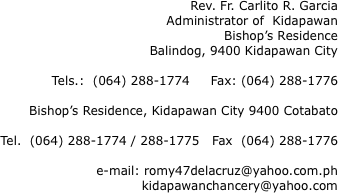The Catholic Bishops' Conference of the Philippines
The Official Website of
CBCP Online

The Diocese of Kidapawan today comprises 9 towns of the province of North Cotabato, 2 towns of the province of Maguindanao and 1 town of Sultan Kudarat. It covers a land area of 1,199 square kilometers and a population of 670,000 people of which 78 per cent are Catholics.
The Formation Programs of the diocese cover the areas of Christian formation, lay leadership, family life, youth, vocational school ministry, and mass media. Service programs focus on tribal Filipinos, justice and peace, community-based health programs and social action.
The Social Action Center of the Diocese of Kidapawan has been institutionalized under the name of GKK-Kidapawan Foundation, Inc. It is the vision of the foundation to contribute to the total development of the people in the diocese, so that they may respond to the people's socio-economic needs, based on limited resources. People's cooperatives are now being established, skills and capabilities developed.
On November 30 to December 3, 1992, the Fourth General Assembly of the Diocese of Kidapawan was held, and the following diocesan goals and thrusts have been approved by the participants for the coming years.
• 1) The building and strengthening of BEC's in the diocese; 2) the increase of Christian involvement in social action; 3) the improvement of witnessing and living out of the faith; 4) the deepening of education; 5) support of the liberating initiatives of the indigenous people; 6) the protection of the richness of nature; 7) support for women's organizations in the diocese; 8) the support of lay organizations to serve the BEC's; 9) the strengthening of the organization of the youth; and 10) the strengthening of the campaign for native religious vocations.
There are 13 parishes in the Diocese of Kidapawan served by 33 priests, and 42 religious sisters. Catholic institutions include 8 Notre Dame schools, 1 formation center and 1 Marian Pastoral Center. There are now BEC's established in the diocese.
The origin of the Diocese of Kidapawan goes back to the first Jesuit missionaries who introduced Christianity in Mindanao in the late 7th century. During the Spanish regime there were frequent encounters with colonizers so the territory remained sparsely settled for the next few centuries.
When the American Government opened up large tracts of land to migration from the north, settlers poured into the territory in waves of thousands, and this continued until the middle of the 20th century.
All this activity and multiplication of the population prompted the Most Reverend Luis del Rosario, SJ, of the then Diocese of Zamboanga to invite the Oblates of Mary Immaculate (OMI) to take charge of the Sulu and Cotabato areas in 1939. The OMI fathers arrived and gradually founded many of the parishes and opened up the Notre Dame schools.
The Prelature of Kidapawan was erected on June 12, 1976. The Most Reverend Federico O. Escaler, SJ, was elected first prelate ordinary and took over the prelature on September 6, 1976. In 1980, Bishop Orlando B. Quevedo, OMI, was elected bishop-prelate, and ordained on October 28, 1980 at the Cathedral of Kidapawan, North Cotabato. On November 15, 1982 the Prelature of Kidapawan was elevated to a diocese. Bishop Juan de Dios Pueblos was appointed diocesan bishop on February 3, 1987.
Mindanao was generally peaceful at the time the first settlers from Visayas and Luzon arrived. Natives and Muslims were friendly to the settlers then. Forests, rivers and wild animals were as yet undisturbed. When the logging companies and the settlers later cleared many areas to open up the rice lands, a few rich settlers began the rubber plantations around Kidapawan. Then land-grabbing became a big issue.
In the early 1970's, the Muslim-Christian conflict erupted. This was branded a religious conflict when in fact it was not. It was actually caused by incidents connected to land-grabbing and to unscrupulous politicians organizing armed groups. Many atrocities were committed and many communities destroyed. When martial law was declared in 1972, the National Democratic Front – NPA again made Mindanao a land of conflict.
It was against this background that the Prelature of Kidapawan was born. This was the term of Monsignor Federico Escaler, and he lost no time in convening the First Prelature General Assembly of Kidapawan in 1977. This assembly articulated the prelature's thrust then as Education for Justice.
In 1980 Bishop Escaler was transferred to Ipil and Bishop Orlando Quevedo took over the prelature. This was a period of intense growth of the basic ecclesial units with an orientation for justice. Many BEC's became centers of hope and solidarity in the midst of the armed conflict. Most lay leaders became targets and some were killed. Included in this carnage was Father Tullio Favali, PIME. Every year Favali's death anniversary is celebrated as a Day of the Martyrs in the diocese.
|
Diocesan Curia |
|
Clergy |
|
Parishes |
|
Educational Center |
|
Institutions |
|
Statistics |

Diocese of Kidapawan
